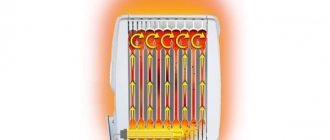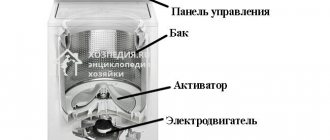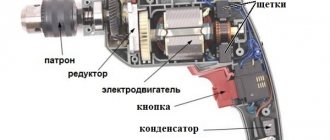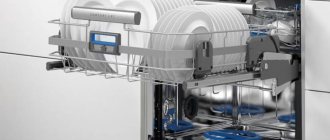There are quite a few PMM models for the kitchen. Moreover, each manufacturer of dishwashing equipment strives to stand out from the rest: some add various sensors to the design of the dishwasher, while others add new units with additional functions.
But, regardless of the brand, the general operating principle of a household-class dishwasher is the same. The main operating units of equipment under different brands are also similar. How does a dishwasher work and on what principle does it work? It is these questions that we will examine in detail in this material. We will also consider basic recommendations for operating dishwashers.
Dishwasher components
Most of the automatic dishwashers currently offered in stores are models built into kitchen units with frontal (vertical) loading of dishes. This technique simplifies the life of a housewife as much as possible.
I put dirty cutlery into the machine, pressed the button - and after a while the spoons, forks and plates were clean again.
Understanding the structure and operating principle of an automatic dishwasher is the key to 100% clean dishes at the end and a long service life of kitchen appliances
In order for the dishwasher to work properly and wash dishes thoroughly, the machine requires water, regenerating salt and detergents. In this case, the water jets must have a set temperature, the salt composition must meet the requirements for NaCl purity, and liquids and washing tablets must be suitable for the specific model.
Each dishwasher unit is responsible for its part of the dishwashing process. If the heating element does not heat the water sufficiently, the pump does not pump it completely, and the ion exchanger or filters become clogged, then the dishes will remain dirty. You will have to stand at the sink and finish the operation of the machine manually. But then why buy a dishwasher at all?
Main components of household PMM
The small body of the dishwasher contains the following working units:
- Circulation pump for water supply.
- Drain pump for pumping waste into the sewer.
- Ion exchanger with resin to soften hard water.
- Instantaneous water heater (heating element with safety thermostat).
- Temperature and liquid level sensors inside.
- Filter for cleaning wastewater from food residues.
- Filter for purifying water supplied to the machine.
- Internal washing chamber with several baskets for different dishes.
- Upper and lower sprinklers (rocker arms with nozzles).
- Display and operating mode selection panel.
- Control block.
Plus, some models are equipped with a heat exchanger, and some with a fan for drying washed dishes.
All the main operating components of the dishwasher are located in the lower part, under the washing chamber: water softening system (1), drainage water inlet with float (2), drain and circulation pumps (3, 4), control board (5) and water supply valve ( 6)
In most PMMs, one pump is used to supply water to the sprinklers and pump it into the drain; the operating mode of the pump in this case is regulated by a special valve
The chamber for dishes is made of stainless steel. To reduce noise, a rubber seal runs along the contour of the hatch door. The cutlery trays are made removable. This allows you to place not only small dishes inside the dishwasher, but also more frying pans or pots.
On the door there is a container for detergent (liquid, powder or tablets). Another reservoir is made at the bottom of the chamber - this is for regenerating salt in the ion exchanger.
On the front of the dishwasher there are machine status indicators or a display, as well as a touch or mechanical control panel. The display-touch version is the most convenient to use, but also the most expensive. At the same time, simpler mechanics in the form of a round handle will last much longer in the vast majority of cases.
The dishwasher has its own basket for each type of dishes - it protects kitchen utensils and glassware from breaking, and also ensures they are washed more thoroughly
A typical dishwasher also includes:
- power cable;
- hoses for draining dirty water and supplying clean water;
- shelves, baskets and trays for dishes.
Special salt and cleaning compounds are consumables. They are not included in the kit, but you should not turn on the dishwasher without them.
Water alone still won’t wash dishes well. Plus, the automatic dishwasher is initially configured to have these products inside. If there are none or they are in insufficient quantities, the machine will not work and the protection will work. We have provided recommendations for choosing the most effective dishwasher detergent in this publication.
Additional elements and devices
The operation of the PMM is controlled by the corresponding automation unit. It sends signals to pumps, heating elements and valves. However, he needs sensors that monitor what is happening inside the operating equipment. And here each manufacturer himself determines the required set of sensors.
There is always one sensor in the car - a water temperature meter. Without it, it is impossible to maintain the proper temperature in the washing chamber. Plus, he also makes sure that the heating element does not overheat.
Also, an automatic dishwasher may have sensors for the composition of the water (the degree of hardness and the presence of impurities in it), the air temperature in the kitchen, as well as the amount of salt and rinse aid in the washing solution
All these sensors are needed to improve the efficiency of the automatic PMM. The more the control unit knows about what is happening inside the chamber with the dishes, the better it is able to select the washing mode.
How is dishwasher drying implemented?
Another additional unit is associated with drying washed cutlery. Almost all models of such machines require such a function. Only the most inexpensive options come without this option.
To dry dishes, the dishwasher is equipped with:
- heat exchanger;
- fan with heating coil;
- block with zeolite.
The first option is a plastic tank inside the PMM. It is filled with cold water and, through simple heat exchange processes, removes excess moisture from the chamber when needed.
After washing is completed, water begins to evaporate from the dishes and settle in the form of condensation just on this heat exchanger and the inner walls of the washing machine. The process is quite lengthy, but such a unit does not require electricity to operate.
The second option is energy dependent, but dries dishes much faster. However, the spinning fan is a little noisy. When choosing a dishwasher with it, you need to make sure that the seal on the hatch performs not only the functions of preventing leaks, but also sound insulation. The lid should close as tightly as possible.
The third option is a new product of the latest generation, which not all manufacturers have in their lineup yet. When absorbing water, the zeolite mineral heats up and releases heat in the form of dry heated air.
This hot air flow is used to dry washed kitchen utensils. Such equipment consumes almost a third less electricity than its counterpart with a fan. Moreover, there is no need to change or add zeolite. It gradually recovers itself and gets rid of excess moisture.
Another interesting function is the projection of the time until the end of washing or simply a red “bunny” from a laser pointer when the unit is operating on the floor covering in the kitchen. The absence of this option is not critical, but its presence simplifies control over the PMM from afar
Dishwasher manufacturers are constantly adding new options to their models to attract buyers. The search for solutions to improve the efficiency of this technology is ongoing. Moreover, the more such additional modules, the greater the likelihood of PMM failure.
We examined each of the main working units in more detail in our article: The structure of a typical dishwasher: design, purpose and maintainability of various parts.
The importance of salt ion exchange
A distinction must be made between detergent and regenerating sodium salt for PMM. These are two different formulations that are poured into different dishwasher containers. “Soap” goes into a reservoir on the lid, and “sodium” is poured into a container at the bottom of the washing chamber.
There are also all-in-one tablets. They are placed in a compartment on the machine hatch and already contain the required volumes of saline solution. But if the water in the tap is very hard, with a high content of magnesium and calcium, then it will be difficult to do without salt specially designed for the ion exchanger. Without it, the PMM will inevitably and quite quickly break down in such a situation.
Special salt in the dishwasher softens water, improves the quality of cleaning dishes and relieves heating elements from limescale, and cutlery from white calcium deposits.
The PMM contains an ion exchanger with a resin consisting of sodium chloride NaCl. The entire flow coming from the water supply for washing first passes through this block, where calcium and magnesium in the water are replaced by sodium ions. As a result, the formation of scale on the parts of the dishwasher and stains on the dishes is eliminated.
Gradually Na is washed out of the ion exchanger and must be replaced with a new portion. Moreover, you cannot use a regular food analogue for this. As a last resort, it is permissible to use coarse-crystalline boiled salt of the “EXTRA” group. But it is best to use only formulations specially prepared for dishwashers with a NaCl content of more than 99%.
The rate of salt consumption is determined by the dishwasher settings. In many PMM models, this process must be adjusted manually using a special table. Moreover, during further operation you will have to constantly monitor the composition of the water and adjust the adjustment.
To save yourself from such a routine, immediately upon purchase choose equipment with a hardness sensor. This way the machine will adjust itself, and NaCl consumption will be as economical as possible. We have provided more recommendations for choosing a dishwasher here.
What items can be washed in a dishwasher?
Ceramic and metal objects can be washed in any mode. Aluminum is a rather capricious substance and contact with hot water and substances used for washing dishes can have a detrimental effect on it. In this case, there is a high probability of corrosion stains appearing. We strongly do not recommend washing aluminum spoons, pots, plates and meat grinders in the dishwasher, since in this case there is a high probability of dark spots appearing on the surface of the dishes. After this, the use of utensils becomes harmful - aluminum particles entering the body have a detrimental effect on internal organs.
If you do wash your aluminum cookware in the dishwasher and find dark spots, it’s time to treat it. Any means will do here: from toothpaste to rust solvent. The safest way is to keep the dishes in a soapy solution. Add a few drops of liquid tar soap to warm, but not boiling, water. Afterwards, dip the darkened objects into the solution. There's no time limit here, so you don't have to worry about adding too little or too much soap to the water.
The method of rubbing with soda is no less popular. A thin layer of baking soda is applied to the damp surface and, after half a minute, you can begin to rub. Remember: under no circumstances boil dishes in a soda solution. This can only worsen the condition of aluminum cookware and accelerate the processes of oxidation and corrosion.
Therefore, to avoid such situations, it is better to wash aluminum items by hand. It may take you some time, but you can avoid corrosion and extend the life of your cookware.
How dishwashers work
To understand how a dishwasher works inside, you do not need to have any special knowledge of high sciences. The operation of an automatic dishwasher is based on the principle of a step-by-step process - first one cycle is performed, then the second, third, etc., and at the end clean cutlery is taken out of the machine.
Salt, water and detergents - these are the three components, as a result of mixing which dirty dishes are cleaned using a similar technique
Washing dishes in a PMM occurs in four stages:
- Pre-soaking (rinsing off large food residues).
- Main washing cycle.
- Rinse.
- Drying.
First, large remnants of uneaten food are removed from the surface of the dish. Then the temperature in the PMM increases and the main washing begins with the addition of detergents. This happens cyclically - collecting and heating water, spraying it around the chamber, draining it into the drain. The number of repetitions of this process depends on the selected washing mode. We talked in more detail about the washing cycle and the duration of the main modes in this material.
Depending on the selected mode, the water temperature in the PMM can reach 65–70 °C, but with an economical operating option it rarely rises above 50 °C, which significantly reduces the electricity consumption of the heating element
Finally, the dishes are rinsed with clean water and dried. If the machine comes with a heat exchanger, then the last stage may take several tens of minutes. If you have a drying fan or a module with zeolite, this happens much faster.
To ensure that water washes all parts of the dishes folded for washing, without exception, the sprinklers constantly rotate during operation. These rocker arms have several nozzles directed to the sides at different angles. The more nozzles there are and, accordingly, the number of jets in the chamber, the faster and more thoroughly the cutlery is washed.
How does it work
The simplicity of the design determines its long service life. The operating principle of a dishwasher is as follows:
- The main components are water, salt and detergent. Their combination provides high cleaning efficiency. Washing dishes without using special products is not recommended.
- Washing takes place in 4 stages: pre-soaking, main cycle, rinsing, drying.
- At the time of pre-soaking, large particles are removed. The main cycle is carried out with increasing temperature.
The final stage involves rinsing with warm water and drying. During operation, the sprayers rotate.
Why do you need a magnet?
The entire washing procedure is controlled by built-in sensors. In this case, it is possible to choose one program from a whole set. A permanent magnet is installed in most cases as a control element.
The solenoid valve is an important part of the device. It opens and closes the flow manually or automatically.
Why do you need an ion exchanger with salt?
For reliable operation of the dishwasher, an ion exchanger with salt is installed. This is due to the fact that too hard water causes scale to form on the heating element and deteriorate the efficiency of the device. An ion exchanger with salt is required for the following purposes:
- Extending service life.
- Increasing the efficiency of the washing procedure.
Special steel is used in the manufacture of the container. It can last for a long period.
What is a check valve for?
Almost all devices have a check valve installed. This device has become widespread in the manufacture of a wide variety of equipment. The purpose of the check valve is the following:
- Protect the device from leakage.
- Elimination of the possibility of reverse current
Manufacturers are trying to make equipment more reliable; for this purpose, various elements are installed.
What are blades for?
The operating principle of the device in question is to uniformly distribute water, which is supplied under pressure. The blades are designed to properly distribute the flow. Their features include the following:
- During production, a material with increased protection against water is used.
- The blades are positioned in such a way that they do not come into contact with the dishes during washing.
The blades are located at an angle relative to the dishes that are cleaned in the sink.
Drying and rinsing process
The inside of the dishwasher is made of steel sheet with an increased degree of protection against moisture. After the main washing cycle comes the final stage, which involves rinsing and drying. They allow you to use dishes almost immediately after washing them. The features of the finishing stage include the following points:
- The flow is sprayed with a larger jet in different directions, thereby ensuring the removal of the detergent.
- Drying involves supplying hot air using a fan. There are also models with condenser drying, which provide the process through evaporation.
The final result largely depends on the effectiveness of the final rinsing and drying. However, a long duration involves the expenditure of excessive amounts of energy.
Rules for using a household dishwasher
Tablets, liquids and powders intended for dishwashers contain a minimum of foaming components. The abundance of foam only harms the process of washing dishes in the PMM. The less it is, the better. Therefore, you cannot use regular soap or anything similar in the dishwasher.
When placing dishes in the basket, you should make sure that they do not lie close to each other - this way the spray jets will not be able to hit closed surfaces and will not wash away all food residues
Not all cutlery can be washed in the PMM. Drying with hot air is contraindicated for plastic. The plate from it will at least soften, and maybe “leak” with plastic drops. In the latter case, the machine will most likely fail instantly.
Glasses and cups should be placed upside down in the basket. This will make it easier for streams from the sprinklers to get inside, plus most of the water will flow out of them by gravity.
And most importantly, nothing should interfere with the movement of the blades with nozzles. This will either break the dishes or damage the sprinklers. We provided detailed recommendations for operating a dishwasher in our other article.
If there are remnants of washed-out food left at the bottom of the washing chamber, this indicates a clogged drain filter. It needs to be cleaned regularly. But the fewer large pieces of food left on the dishes, the less often you will have to take it out and wash it, so it’s better not to be lazy in the beginning and carefully remove large leftovers from the plates.
Have you discovered that your dishwasher is clogged? In this case, we recommend that you familiarize yourself with DIY cleaning tips.
Filters and drain pump
Once the dirty water has drained from the plates, the liquid is purified for reuse. Two filters are occupied:
- rough - cylindrical, screwed into the bottom of the working compartment;
- fine – mesh around a coarse filter.
To explain the work, you will have to find out why the powder and rinse aid are needed. If we look at the question of how a dishwasher works, in a simplified way, we will highlight three main stages of the cycle:
- Washing with detergent.
- First rinse with cold water.
- Second rinse with hot water and added rinse aid.
Soaking aside, if you take a closer look at the water consumption of a dishwasher, you'll have to double the size of the review. In the first round, detergent is added. Residues of food fall to the bottom, keeping the filters occupied. Part of the water passes through the mesh to the second circle, the other must first get rid of the crumbs with a cylinder.
Sometimes you have to unscrew the filter and clean it, most of the dirt is removed automatically. The process continues in circles until special sensors decide: the liquid is so dirty that it’s time to pour the waste into the sewer (read below).
If the quality of, for example, the first step is satisfactory, the machine moves on to the second. Cold water is refilled so as not to damage fragile dishes; a heat exchanger is installed behind the wall of the working compartment. Having passed through it, the stream is not cold. Helps avoid temperature shock. The final rinse will be hot, making the drying process easier. If you heat the water in the second step, the glasses will not crack due to temperature changes.
The rinse aid is contained in a special compartment in the door and is poured inside as needed. The powder is nearby, poured in the same way, but in the first step. The consumption of detergent by the dishwasher is regulated by special sensors, which are often used to monitor the amount of foam. And the drainage pump handles the waste liquid. The unit is designed to allow crumbs and other food debris to pass through. The drain hose for the same purpose is larger in diameter than the inlet hose. Restrictions are imposed on the laying of communications in order to reduce the electricity consumption of the dishwasher and make life easier for the pump.
We didn’t understand whether both pumps operate from the same engine through a gearbox; it’s more likely no than yes. The reader has more information, having a dishwasher suitable for disassembling and analyzing the device.
Distinctive features of some dishwasher models
Some dishwashers have distinctive features. For example:
- Availability of a heat exchanger. This significantly reduces energy costs during drying, but takes time.
- Availability of a sensor. It determines how clean the water entering the machine is.
- The presence of a sensor that determines whether there is detergent.
- The presence of a drying sensor. It determines the level of dryness and humidity of washed dishes.
- Availability of fasteners for fragile dishes and glasses.
- Availability of a turbo drying system. It provides ultra-fast drying of dishes.
- The presence of backlight when opening the door.
- Durable transparent glass. Used as a decorative element.
- Projecting on the floor information about the remaining time.
You can additionally wash root vegetables in the dishwasher without using detergent. It is possible to wash various combs, rubber shoes, children's toys, and even cook food by simmering or steaming.
Additional functions of PMM
In parallel with dishwasher modes, they can also have additional functions. Almost all of them are equipped with leakage protection. If there are small children in the house, you need a unit with the ability to lock the control panel or door.
The ability to add forgotten dishes after starting the machine is also a very convenient feature. Elite models are equipped with loading sensors. In this mode, the PMM selects both the volume of water and the time spent on the cycle.
Some models have additional elements - sensors for monitoring water purity and hardness. A sensor for monitoring the degree of water purity forces the unit to rinse everything loaded into the machine until the liquid becomes perfectly clean. If the water is very hard, the machine will determine how much softening salt to add.
The panel for launching additional functions for built-in PMM models is located at the end of the door
Built-in units in working condition project a red beam onto the floor plane. When the process is completed, it disappears or its color changes to green. This is very convenient, because... makes it possible to monitor the operation of the built-in dishwasher.
Control of washing modes
All modes in the PMM are coordinated in two ways: electromechanical and electronic. The second method is more comfortable, and all modern models are equipped with it. The first provides for the presence of buttons, switches and keys on the body, and they are controlled manually.
Control of some PMM models is simplified due to the presence of clear symbols in the designation of standard programs. These are glasses, pots and other items (+)
With electronic control, both the washing mode and other programs are set using commands. If the PMM board fails, only a specialist can repair it. Experience shows that most often the programmer will have to be changed.
The final stage of machine operation
At the end of the cycle, the contaminated liquid goes down the drain. This is followed by a drying stage. It can end in 30 minutes or last more than an hour.
A special signal sent by the device will notify you of the end of the program. The sound volume is adjusted using convenient indicators placed by the manufacturer on the control panel. With their help, you can completely disable the alert function if you plan to load the machine overnight.
When the unit stops completely, press the on/off button. Then the door is opened slightly to allow the dishes to cool faster.
After drying, a high temperature remains inside the unit, so it is not recommended to immediately empty it of its contents. In addition, cookware made from certain materials becomes very fragile when hot.
After the beep sounds indicating the end of the wash, you should wait a while before removing the dishes.
It happens that the cycle is completed, but the dishwasher does not turn off. The most likely cause is an electronic problem. This may also be a consequence of blockage of the drain hole with food debris. The machine cannot shut down correctly.
Dishwasher diagram
You roughly presented the principle of operation. But to understand better, you need to know where each part is located. In the picture we show how the PMM works from the inside:
- Basket for dishes.
- Closer for smooth opening/closing of the door.
- Rocker.
- Thermal sensor.
- Coarse “glass” filter.
- Drain hose.
- Pressure valve.
- Drain pump.
- Water container.
- Leakage protection device.
- Electronic module.
- Circulation block.
- Capacitor.
- Compartment for rinse aid.
- Door lock.
- Detergent compartment.
- Intake valve.
- Door seal.
- Salt compartment.
- Flow-through heating element.
- Intake hose.
- Guide for baskets.
For a description of how to disassemble a dishwasher, read our article.
We will consider below what is needed for the machine to operate efficiently.
Water saving level in dishwashers
Both the selected washing mode and the PMM model determine how much water it will consume. On average, this is from 10 to 13 liters per procedure as a whole. Unlike manual washing, all water is used only for its intended purpose without any loss.
During the process, the working fluid is cleaned using special filters and is supplied completely renewed for rinsing. Economy modes reduce the amount of water consumed by 25%.
Water savings when using PMM are obvious. The unit uses a special technology in which the collected water is used several times
The profitability of PMM is indicated by symbols. Highly economical units are marked with the letters A, B, C. They consume 9 - 16 liters. Average-economical dishwashers are designated in the form of the letters D, E. They consume slightly more water - up to 20 liters. Low-efficiency machines with the letters F, G require 26 liters per cycle.











